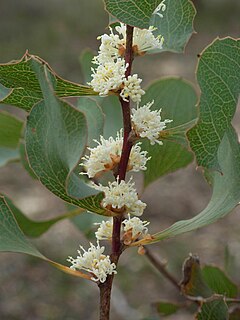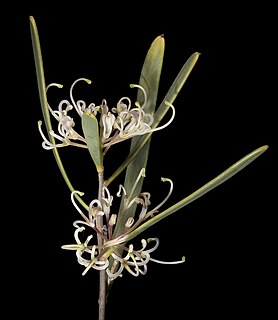
Hakea scoparia is a species of flowering plant in the family Proteaceae and is endemic to the south-west of Western Australia where it grows in shrubland. It is a shrub with ascending branches, terete leaves and clusters of cream to pinkish flowers in leaf axils from June to September.

Hakea cygna, commonly known as the swan hakea, is usually a dense shrub endemic to Western Australia with creamy-white upright flowers appearing from July to August.

Hakea trifurcata, commonly known as two-leaf, two-leaved hakea, or kerosene bush, is a shrub, endemic to the south-west of Western Australia. The species has two leaf forms, needle-like or oblong egg-shaped. Unlike most hakea species the fruit remain green at maturity and resemble the broader leaf form. The mimicry creates a camouflage, reducing predation of the seed by granivores in particular cockatoos.

Hakea denticulata, commonly known as stinking Roger is a shrub tree endemic southern Western Australia. One of the many species of Australian plant described by the botanist Robert Brown. A compact shrub 1–2 m (3–7 ft) high and wide with red flowers in the spring with an unpleasant odour.

Hakea cristata, commonly known as the snail hakea, is a shrub in the family Proteaceae native to Western Australia. An ornamental prickly shrub with attractive foliage and creamy white rounded flowers appearing in profusion in the winter months.

Hakea ambigua is a shrub in the family Proteaceae. In favourable conditions may grow into an attractive weeping shrub with creamy white flowers. Only found in the Stirling Ranges of southern Western Australia.

Hakea anadenia is a shrub in the family Proteaceae, native to near the west coast of Western Australia. The fragrant creamy-white flowers appear in profusion from late winter to spring, but do not produce nectar.

Hakea bicornata is a shrub in the family Proteaceae native to Western Australia, with attractive creamy-white flowers and fruit with two distinctive horns.

Hakea candolleana is a shrub in the family Proteaceae native to areas along the west coast in the Wheatbelt and Mid West regions of Western Australia. A cream-white winter flowering species, useful as a garden ground cover.

Hakea cinerea, commonly known as ashy or grey hakea, is a shrub in the family Proteaceae native to areas along the south coast in the Goldfields-Esperance region of Western Australia. It is a showy ornamental species bearing creamy-white flowers aging to orange with contrasting ash coloured grey-green leaves.

Hakea conchifolia, commonly known as the shell-leaved hakea is a shrub in the family Proteaceae native to an area in the west coast of the Wheatbelt region of Western Australia. An attractive small species with unusual rigid leaves that encircle the flowers.

Hakea costata, commonly known as the ribbed hakea, is a shrub in the family Proteaceae native to Western Australia. A multi-stemmed small shrub producing attractive pink or white brush-like blooms rich in nectar from July to October.
Hakea tuberculata is a flowering plant in the family Proteaceae and is endemic to several isolated areas along the coast in the Peel, South West, Great Southern and Goldfields-Esperance regions of Western Australia. It is an upright shrub with white flowers and rigid, prickly leaves.

Hakea meisneriana is a shrub in the family Proteaceae and is endemic to Western Australia. It has small, nectar rich, creamy white flowers in clusters in the upper branches from August to November.

Hakea newbeyana is a shrub in the family Proteaceae and is endemic to an area in the southern Wheatbelt and Goldfields-Esperance regions of Western Australia. It is a prickly shrub with smooth grey bark and sweetly scented cream-yellow flowers in profusion in spring.

Hakea smilacifolia is a shrub in the family Proteacea. It has sweetly scented flowers, stiff leathery leaves and is endemic to an area in the Mid West, western Wheatbelt and the Goldfields-Esperance regions of Western Australia.

Hakea stenophylla is a shrub or tree in the family Proteacea, with sweetly scented creamy-white flowers. It is endemic to Western Australia.

Hakea vittata, commonly known as the striped hakea, hooked needlewood, is a shrub of the family Proteaceae. Restricted to an area on the Eyre Peninsula and the Gawler Range in South Australia and small areas in eastern Victoria.

Hakea fraseri, is a species of shrub or small tree commonly known as the corkwood oak, is a shrub in the family Proteaceae and is endemic to northern New South Wales. It has furrowed bark, pendulous foliage and creamy-white flowers in spring.
Hakea leucoptera subsp. sericipes is a small tree with cylinder-shaped leaves and clusters of up to forty-five white fragrant flowers. It is found in northwestern New South Wales, Queensland and Western Australia.



















